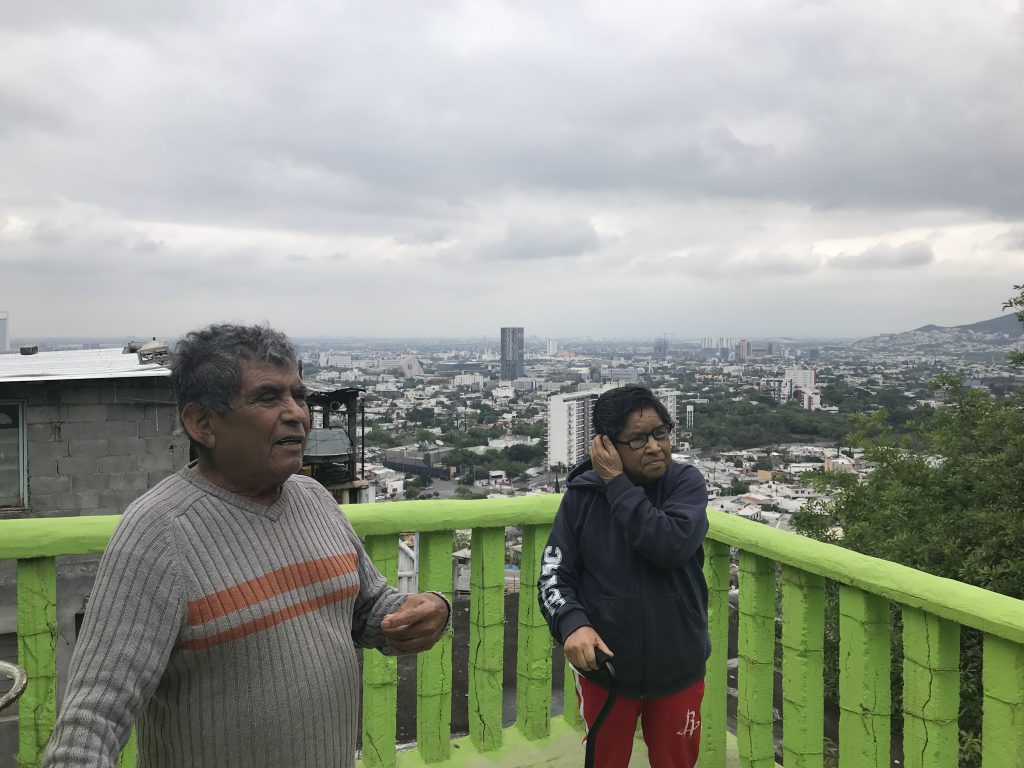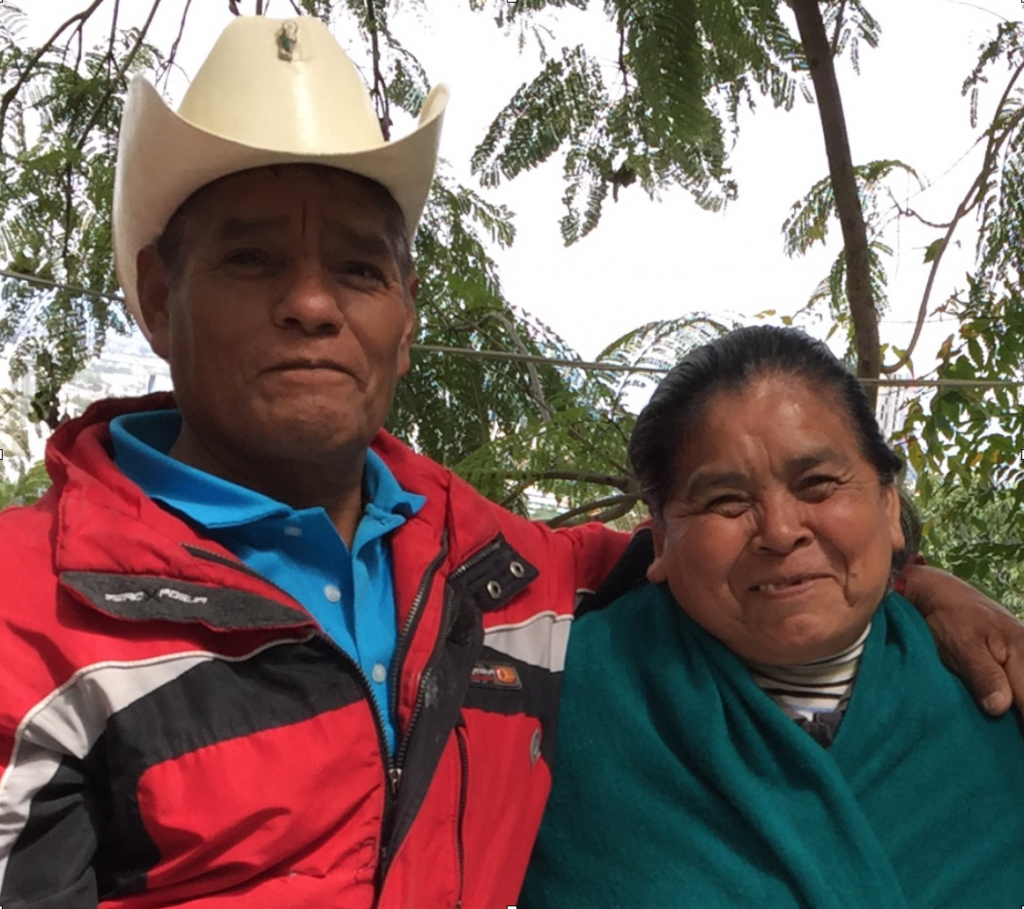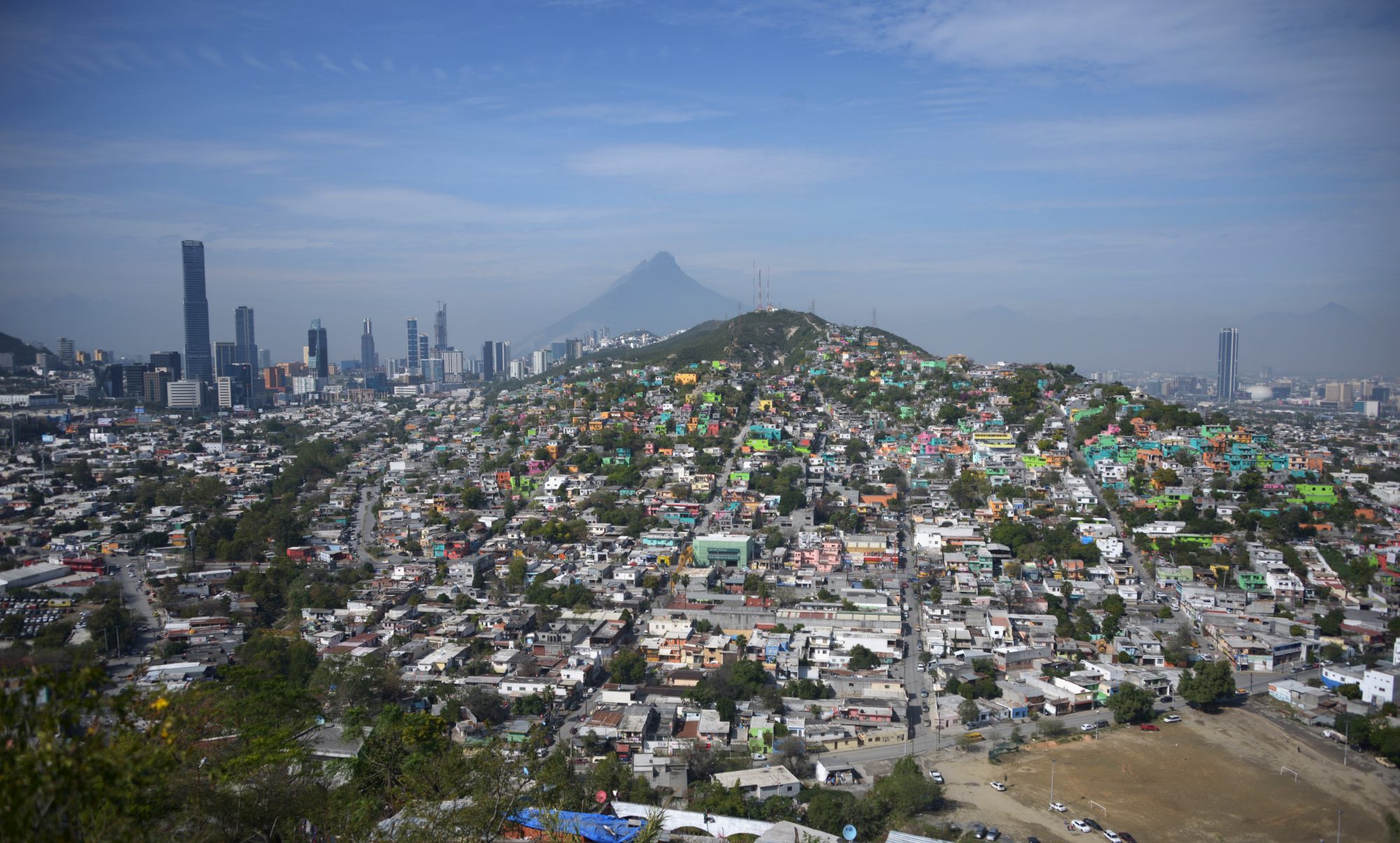Santos y Rumuelda: Some of La Campana’s First Settlers
by Camille Garcia

If Santos Rodríguez had to put a price on his home, it would be $1 million pesos.
It’s a big upward jump from the price at which the Mexican government values it – around $300,000 pesos. But like every home in his neighborhood, El Cerro de La Campana, Santos’ house was built little by little, by him and his family.
This effort, which took about 10 years to complete, has made his home very valuable, Santos said one gray afternoon in March. He and his wife, Rumuelda, invited us into their home to tell us about their lives, and how they came to settle in La Campana, a humble hillside community just minutes away from the historic center of Monterrey, Mexico.
The couple first settled on their plot in La Campana in 1971. As newlyweds, they left their respective family ranchos in San Luís Potosí to find a better life in Monterrey for them and their children.
When they arrived, the cerro was mostly empty toward the top of the mountain – where they live – though some families had already settled toward the bottom of the hill. There was wildlife such as coyotes and rabbits running free, Santos said. The family, including Santos’ brother, began to build up their home, which was no easy task. They carried pieces of wood, cardboard, and corrugated iron on their backs, Santos said, up the hilly terrain to their compound to build with. Over time, the structure evolved from a one-room dwelling made of wood, iron sheets, and cardboard to a permanent, concrete multi-structure compound.
“It’s been a lot of work,” Santos said. “Here, everyone comes up the hill with whatever [supplies] they can and that’s it.”
The Rodriguezes were some of the first settlers of La Campana, which has since grown from a small community dotting the expansive hillside to a robust neighborhood of about 5,000 people. The neighborhood is considered to be an informal community, which is a community that hasn’t been officially planned for development by the local government.
Much of La Campana now has running water and electricity, along with other resources such as community groups, neighborhood businesses, and pocket parks. And Santos and Rumuelda have witnessed the neighborhood’s growth alongside their own.
The couple is warm and friendly. The walls of their home are adorned with family photos and portraits of the pair from decades ago. A pot of pinto beans sits simmering on the stove top next to another pan full of fragrant papas mixed in a spicy chile sauce, all freshly made by Rumuelda.

Most of the couple’s day takes place in their home, they said. Santos wakes up very early. Rumuelda cooks their meals, everything from frijoles to sopa to huevos con chorizo, with fresh corn tortillas delivered to their home by a neighbor, a little girl about nine years old.
Times were different when they first came to La Campana. Santos worked as a musician, playing norteño music in cantinas, while Rumuelda maintained the home and raised their nine kids. As more people arrived in La Campana, some neighbors began to organize together to get more official connections for water and electricity. The Rodríguezes have both of these resources for the most part, but the services are typically shut off for a few hours in the night, they said.
A local La Campana organization – Barrio Esperanza – was established WHEN, and also has helped organize neighbors to create and maintain resources for the community. One of the organization’s best efforts, Rumuelda said, was installing a series of pocket parks in the upper part of the cerro, where she lives.
“Here they’ve made little parks for the kids who live up here so they don’t have to go down [the hill] … where there is more danger because of cars passing,” Rumuelda said. The parks are good, she added, because they give the kids a safe place to play that’s also close to their homes.
Rumuelda and Santos are comfortable in their home, but they’ve still had issues in La Campana that will likely only get worse as they age.
A big issue, they said, is accessibility. Their home, for example, is located atop a steep part of the hill, where cars cannot go. In January, Santos had a bad fall when he was walking down the hill, and the couple worries about how long it would take for an emergency team to get to them if they ever needed to go to the hospital for any reason.
Still, the Rodríguezes hope to remain in their home for as long as they can. It is not hard to imagine why. They built it themselves. They have a beautiful garden full of colorful flowers out front, a warm retreat inside, and an impressive view of all of Monterrey from their second-story patio.
“Para mi,” Santos said, “[esta casa] cuesta un millón.”
And as we looked at the vast urban landscape of Monterrey from atop the Rodríguezes patio, it wasn’t hard to imagine why.
____________________________________________________________________
Cultivating connectivity / Cultivando conectividad
by Eric Nava-Perez
We were making our way back down the cerro when Don Pedro reached down to the ground and picked up an orange. He inspected the orange, running his elderly but strong fingers around it and said to me, “Les hace falta agua (They need water).” Don Pedro peeled the orange and added, “Son dulces (They are sweet).” He gave me half of the orange so that I could confirm what he said and what he tasted.
I believe in Don Pedro’s knowledge of agriculture because he had just told me that he had grown up on a rancho in the Mexican state of San Luis Potosi. At the young age of 12 he started to work on farms. He confessed that some were owned by foreign companies. Eventually, he married, grew his family, and moved to El Cerro de la Campana with his wife Doña Josefina and their children.

It was the first day we met with the neighbors of La Campana and, at the request (or suggestion) of Celina Fernández – the founder of a nonprofit Barrio Esperanza in La Campana – we all hiked up the cerro to visit the pocket parks that Barrio Esperanza had already built. It was a beautiful Sunday afternoon, with some clouds and plenty of sun. I was curious as to why the neighbors were not at church or whether they even went to church on Sundays. It was on the topic of faith and spirituality that Don Pedro and I first began our conversation that day.

Don Pedro began telling me a story of himself. He told me that as a young boy he was constantly ill and that he had procured some type of large blemish that covered his entire chin. Some elders advised that he go to a local site revered by many to perform a ritual there that would help his affliction. Don Pedro, with an amazed expression, said that it indeed improved his health. He spoke fondly of the site. In that moment I did not know what to make of this story, but I was very happy to have Don Pedro confide in me. I followed up with questions about his rancho.

Before leaving that part of the cerro, we stopped by one of Barrio Esperanza’s offices located nearby. We discussed the pocket parks, which the locals that came up with us had not seen before. Witnessing the pocket parks first hand gave them an idea of what is possible to create in their part of the neighborhood. A young boy named Jesús was especially excited. Later that week he told his friends about what he saw further up on the Cerro de La Campana. But, before doing so, he and I shared some special, non-verbal moments. Jesús, through body language, expressed cariño toward me. It was not clear to me why, perhaps it was the fact that he saw me speaking with his grandfather, Don Pedro, in a way that he deemed friendly and he figured that I meant well. Or, perhaps, it was that we both liked the same soccer team? If I had to bet on one of the two reasons, I would bet on the latter. Throughout the remainder of the week Jesus would help me with other menial tasks, like carrying the portería to its new location. I think Jesús looks a lot like his grandmother Doña Josefina.

Jesús’ father, Avelardo, also joined our hike up the cerro. He kept to himself for most of the hike, but occasionally he spoke with his father in law, Don Pedro, about the pocket parks and other construction related topics. Yet the way in which Avelardo carried himself gave me a sense of generous authority. This initial impression was confirmed throughout the week and beyond. Avelardo’s knowledge of building materials proved to be instrumental in the construction of the Parque de Los Niños, the park that this part of the community decided to plan and construct in their part of the neighborhood.
By the end of the week, Don Pedro’s positive spirit manifested itself in the form of the first monetary contribution to the fund for the park. His spirit was contagious, and others followed suit, including another of his grandchildren – 12-year-old Alexander – who works at a local grocery store packing bags. This seemingly small act of good faith, like his story, illustrates the values that guide their judgement: faith in the community around them and the capacity to transcend disparate interests through community engagement. These are values that I have also held dearly, once before. And I have been reminded of their ongoing importance to me through the work I do.

